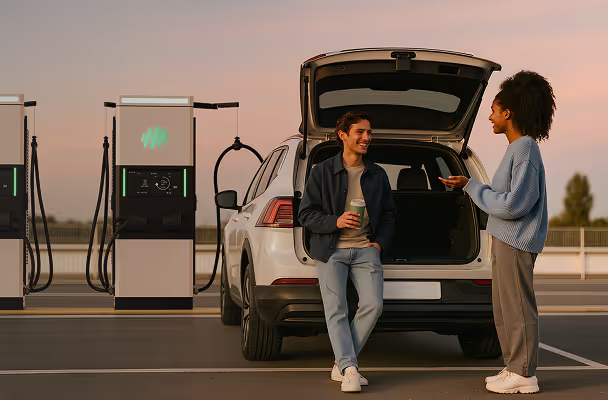EV Charging on Indian Highways : How to Make It Work
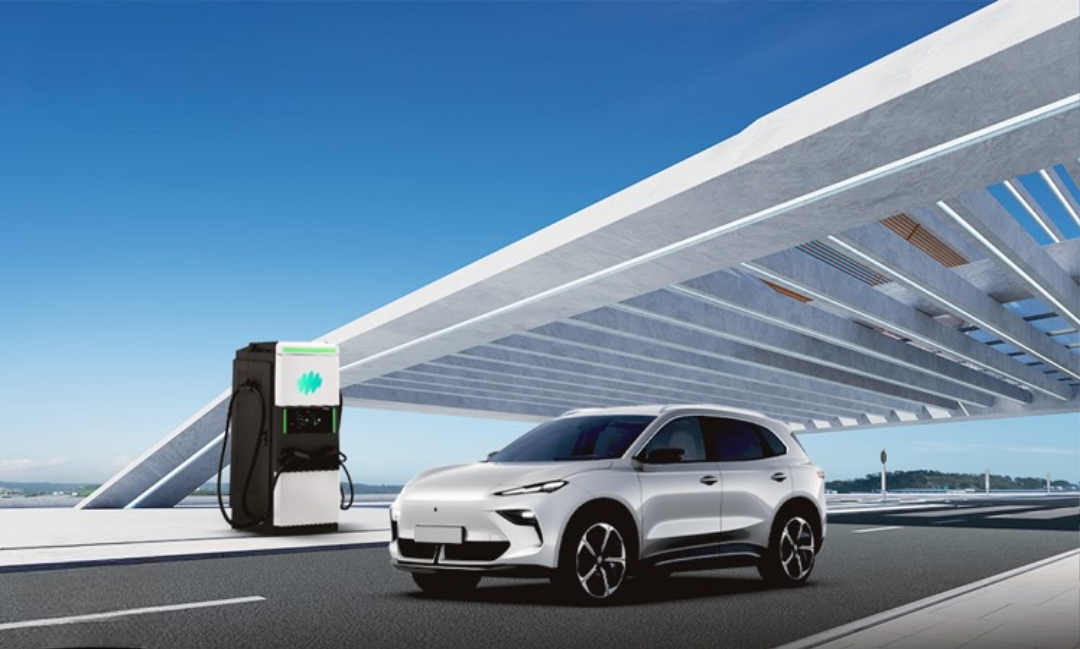
Welcome to the third episode of our blog series on ‘different shapes and forms of electric vehicle (EV) charging’. We’ve seen charging at work and home, but how will EV drivers tackle long road trips? Join us as we investigate the future of fast charging infrastructure along Indian expressways and its role in shaping long-distance EV travel.
India’s EV market is growing. In FY 2023–24, over 1.6 million EVs were registered across the country. EV adoption is rising, but most chargers are installed in cities. This urban focus creates an imbalance. It makes EVs seem unsuitable for long journeys, giving rise to range anxiety. It also limits adoption in smaller cities and rural areas.
EV Charging on Highways is Important for EV Adoption
To end range anxiety and push EVs beyond urban clusters, India needs highway-based EV charging infrastructure. India has over 6.3 million kilometers of roads: the second-largest network in the world. Of this, national highways cover about 161,000 km. On paper, this may be 2% of the network. But they are still the most important arteries of India’s transport system, for 3 primary reasons.
- They connect cities, towns, and villages.
- They are the key to logistics and trade.
- They handle around 40% of road traffic.
Building EV charging infrastructure in highways is critical for EV adoption. EV charging stations here enable longer trips and reduce range anxiety. This is key for new EV users and fleet operators. Given the exponential expansion of highways and EV charging infrastructure, EV charging stations on highways is a natural next step.
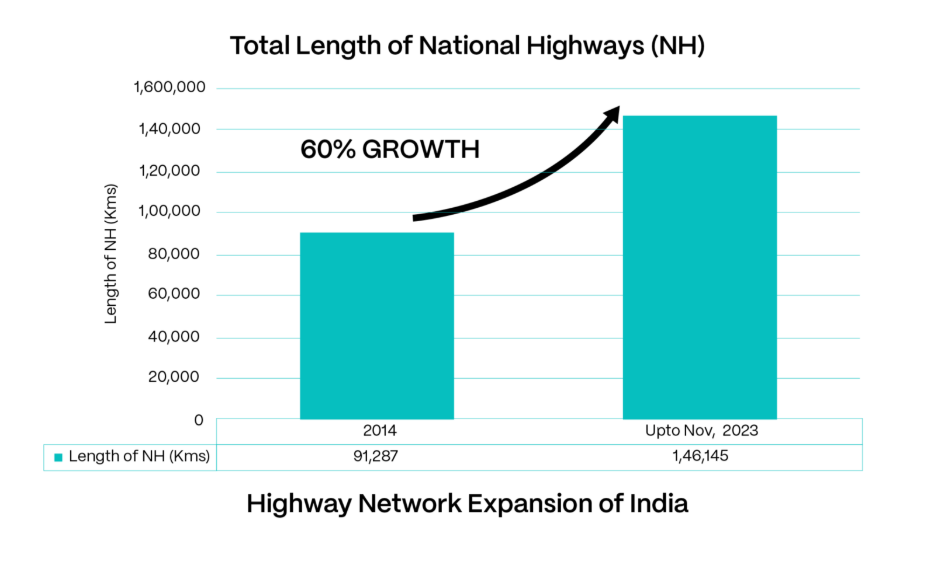
According to Union Minister for Road Transport and Highways Nitin Gadkari, 4,557 public EV charging stations are now operational across the country’s highway network. These EV charging stations serve a stretch of 146,342 kms.
Building EV Charging Stations on a Highway is Complex
But scaling EV charging network, especially along highways, hasn’t been an easy task. Highways cover vast, low-density areas. Setting up a single DC fast charger can cost ₹3–7 lakh, excluding land, grid, and permit costs. Private investors worry if they will see enough usage for such an investment. Rural grid reliability is another issue. Fluctuating voltage can cause EV chargers to go offline, damaging user trust.
Recognizing these gaps, the government has stepped in.
The National Highways for EVs (NHEV) initiative, launched under the Ease of Doing Business program, is the most ambitious public effort to electrify India’s highways. NHEV now aims to electrify 5,500 km of national highways with over 260 charging points and battery-swapping stations.
The PM E-Drive scheme, launched in late 2024, has earmarked ₹2,000 crore to deploy 22,100 public chargers by 2026.
This has piqued the interest of multiple stakeholders, leading to innovative approaches towards EV charging.
Collaborative Pilot Projects Have Seen Success
Recent projects have shown that it’s possible to create profitable EV charging stations.

Here are some details of the 3 projects by NHEV:
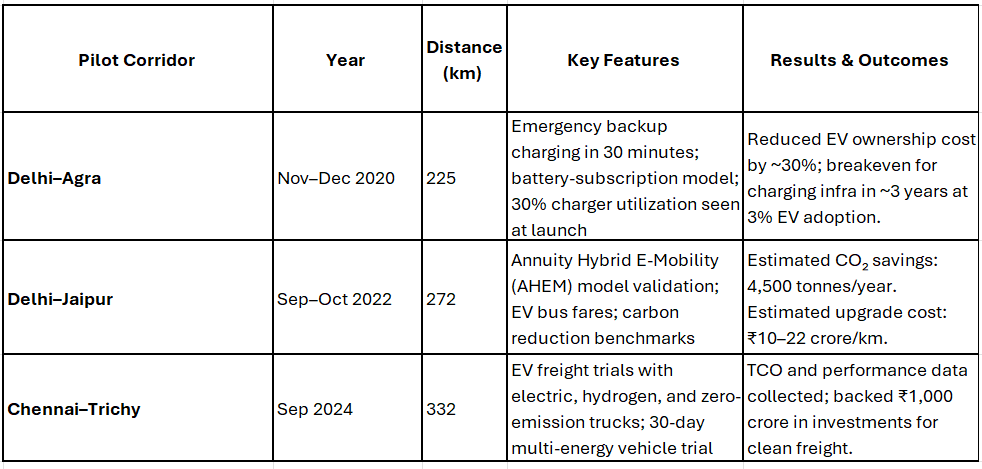
All 3 of these projects involved collaboration among multiple stakeholders. Let’s have a look at the kind of partnerships done and why it makes sense.
Innovative Partnerships have Made EV Charging Profitable
One of the standout examples is the Annuity Hybrid E-Mobility (AHEM) model under the NHEV initiative. This hybrid PPP structure spreads financial risk between government, private players, highway authorities, and even citizen investors. Such shared responsibility has helped stations reach breakeven in just 36 months, a critical factor in scaling the model across the country.
But innovation isn’t only financial. India is also tapping into its existing highway ecosystem to fast-track EV adoption.
- Toll plazas, petrol pumps, and highway hotels are being upgraded into EV charging hubs. These locations already offer parking, basic infrastructure, and visibility, all of which make them ideal spots for setting up EV charging stations.
- Public oil companies like IOCL, HPCL, and BPCL are now rolling out chargers at thousands of fuel stations across national highways.
The success of this rollout depends on where and how fast these chargers are deployed. Fast and ultra-fast DC chargers, capable of delivering 100–350 kW, are being strategically placed every 40–50 km along key stretches. The idea is to ensure that EV users are never too far from a top-up point.
To see how this strategy is playing out on the ground, here are a few early examples of successful EV charging station deployments along key highway corridors:
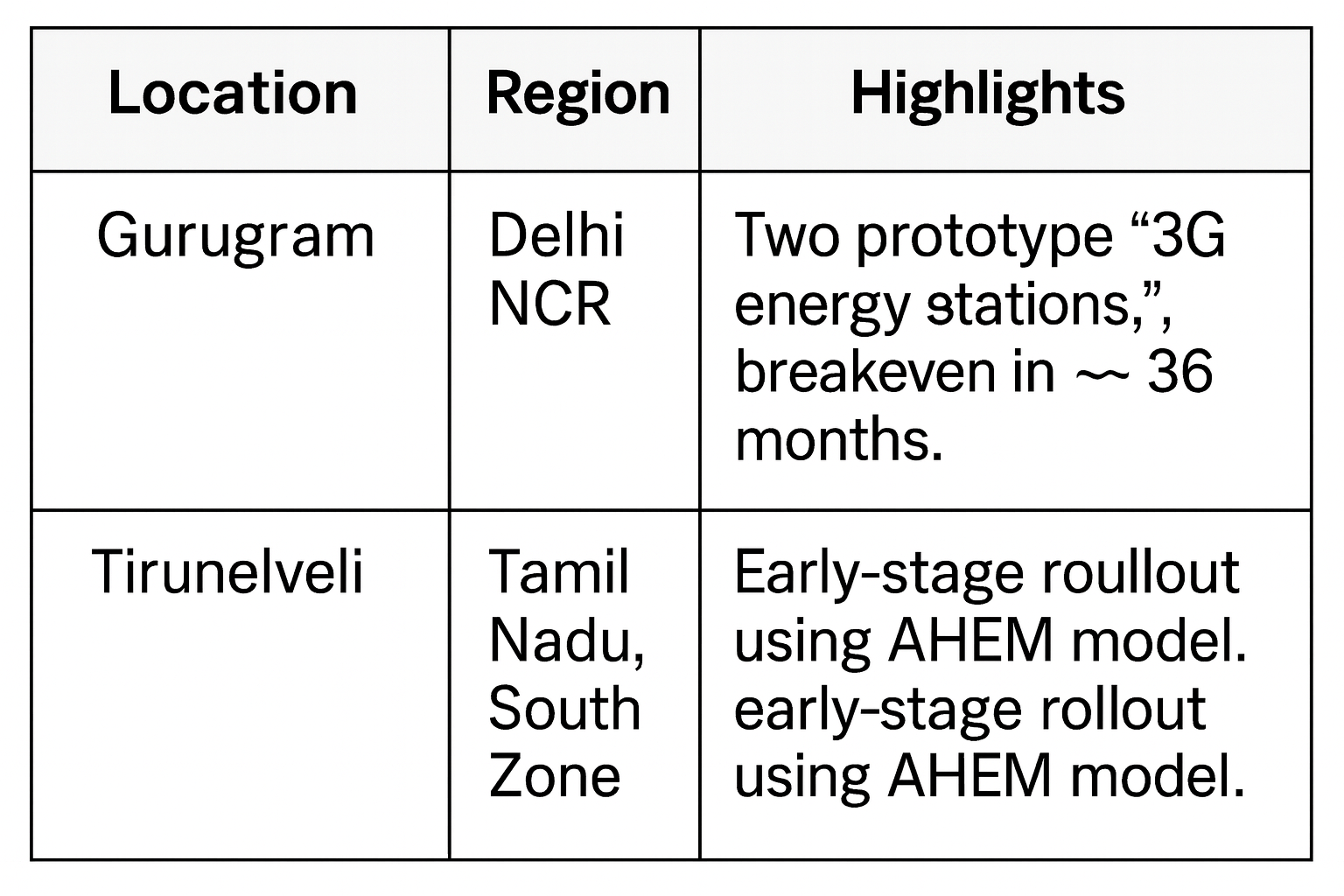
EV charging integration in these setups could happen because of smart usage of technology. Let’s look at how technology elevates EV charging.
Smart Use of Technology Is Simplifying the Whole Process
Real-time charger visibility, slot booking, and UPI-enabled payments are now being integrated into centralised mobile apps to simplify the EV user experience. These apps leverage IoT (Internet of Things) sensors embedded in chargers to provide real-time updates on charger availability, operational status, and power output. This means users can instantly view nearby charging stations, check whether a charger is free or in use, and avoid long waits or detours.
Advanced algorithms also help optimise slot booking by predicting demand patterns and suggesting the best time slots or alternative stations. Integration with UPI and digital wallets ensures quick, secure, and cashless payments, reducing friction in the charging process.
Platforms like the Unified EV Interface (UEVexperienceI) are playing a critical role in unifying this fragmented ecosystem by aggregating data and services from multiple charging operators. This creates a seamless, pan-India charging network where users don’t need to download different apps for different operators—just one interface to access them all.
Over time, such platforms can also enable predictive routing, dynamic pricing, and even vehicle-to-grid (V2G) communication, marking a shift towards intelligent, user-centric EV charging infrastructure.
Sustainability is also baked into the design. Many highway stations are being powered by solar rooftops and backed by on-site battery storage. This reduces dependence on the main grid and helps maintain uptime even in remote areas.
By combining finance, tech, and clean energy — India is building an EV charging model that’s smart and scalable. But how do we apply it in on the ground?
Partnerships with Highway Dhabas Can Create Profitable EV Charging Hubs
If you’ve ever driven long-distance in India, it’s highly likely that you’ve stopped at a dhaba. These humble eateries, spread across every major highway, have long been the go-to spots for food, rest, and a break from the road. Their very nature, open spaces, basic infrastructure, and steady footfall, makes them perfect candidates for India’s next big EV move: highway charging hubs.
Dhabas Are Located at Ideal Distances for EV Charging
The opportunity here is massive. Dhabas are already located every 40–50 km on most highways, the exact spacing recommended for EV charging stations. This makes them ideal for co-locating fast and ultra-fast chargers, converting these rest stops into multi-purpose EV hospitality centres. Imagine this: while your EV charges in 30 minutes, you freshen up, have a meal, and maybe even browse a small retail corner. Charging becomes part of a natural, comfortable travel routine.
EV Charging in Highway Dhabas Can Create Multiple Revenue Streams
But this isn’t just about convenience, it’s a solid business proposition. By modernising their space, dhaba owners can tap into multiple revenue streams. Besides charging fees, there’s potential to boost food and beverage sales, offer paid amenities like clean restrooms and Wi-Fi, and open kiosks or retail counters. Advertising too becomes a key revenue source, both digital and physical, at a time when brands are keen to associate with green mobility.
EV Charging in Dhabas Boosts Local Economy
This model can also spark local entrepreneurship. By upgrading existing setups, dhabas can hire local staff, source regional food, and even offer EV-related services like tyre repair or battery check-ups. The result is a new rural economy built around clean transport. Over time, we’ll likely see clusters of dhabas evolve into EV-friendly micro-markets, offering consistent charging, food, retail, and services, much like mini highway malls.
An Example : Old Rao Dhaba on Delhi-Jaipur Expressway
Some early adopters are already showing what’s possible. Old Rao Dhaba on the Delhi-Jaipur route has installed high-speed chargers, drawing EV drivers alongside traditional diners. For this to scale nationwide, successful partnerships are essential, between CPOs (charge point operators), dhaba owners, power utilities, and local governments. With the right incentives and shared benefits, dhabas could go from being roadside food joints to key enablers of India’s highway EV revolution.
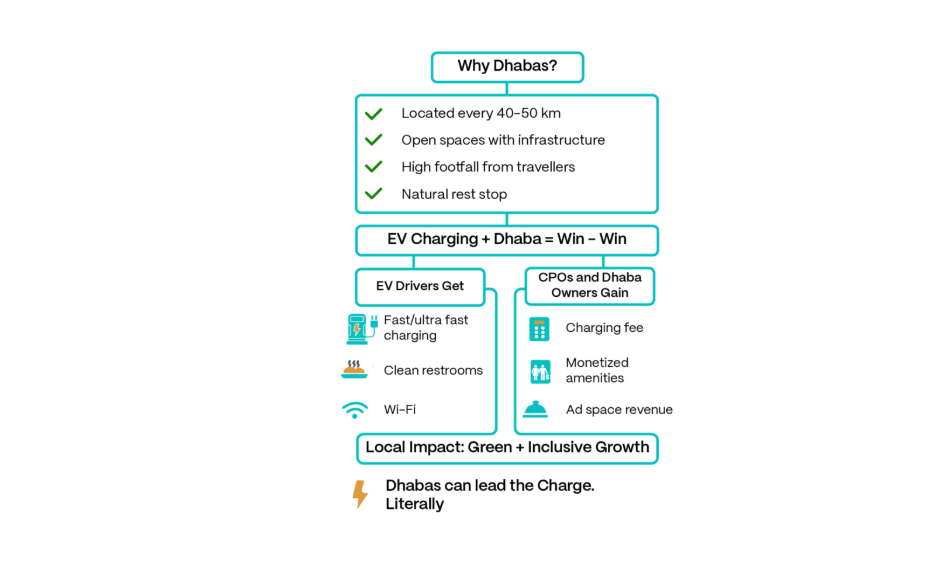
Innovation in Highway Ev Charging Can Accelerate EV Adoption
Highway EV charging infrastructure is giving a huge boost to EV adoption.
- The growing visibility of EV charging stations along highways is building public trust in electric mobility, directly boosting purchase intent.
- By enabling seamless long-distance travel and reducing range anxiety, it makes EVs a viable option for every Indian commuter, not just urban users. Increased charger visibility builds confidence, accelerating adoption and creating a robust market. When highways connect EV ecosystems to rural and intercity routes, they broaden the user base and normalize electric mobility everywhere.
An EV charging station on a highway is not just about convenience. it’s about transformation.
This infrastructure also aligns directly with India’s decarbonization goals and renewable energy ambitions, driving cleaner mobility. Importantly, the transition is inclusive: fueling job creation and entrepreneurship in highway regions. With the right policies and partnerships, highway charging becomes more than a pit stop. It becomes a catalyst for economic, social, and environmental progress.
FAQs :
Are fast EV charging stations available on Indian highways now?
Yes, India is rapidly expanding fast-charging stations across highways, so EV users can now top up their battery in just 30-60 minutes during road trips.
What is the PM E-Drive scheme and how does it support EV charging?
The PM E-Drive scheme is a government-backed plan to set up over 70,000 public EV chargers across cities and highways, boosting access for both urban and long-distance EV users.
Can I charge my electric car at highway dhabas or rest stops?
Absolutely. Many highway dhabas and rest stops are now being upgraded with EV chargers, letting you grab a meal while your car powers up, quick and convenient
Glossary
- Range Anxiety
The fear among EV users of running out of battery without access to a nearby charging point, especially during long trips.
- EV (Electric Vehicle)
A vehicle that runs on electric power, either fully (battery electric) or partially (hybrid), instead of conventional fossil fuels.
- DC Fast Charger
A type of EV charger that can quickly charge a vehicle’s battery by delivering direct current (DC), typically providing 80% charge in 20–30 minutes.
- NHEV (National Highways for Electric Vehicles)
A government pilot project aimed at developing electric highway corridors with fast-charging infrastructure across India.
- AHEM (Annuity Hybrid E-Mobility)
A hybrid public-private partnership (PPP) model under NHEV that distributes investment risks across stakeholders for EV charging infrastructure.
- PM E-Drive Scheme
A national program launched in 2024 to promote electric mobility by deploying public EV charging stations and incentivizing adoption.
- Unified EV Interface (UEVexperienceI)
A centralized mobile platform that integrates real-time charging station data, bookings, and payments across multiple operators for seamless EV charging.
- Charge Point Operator (CPO)
Companies or entities responsible for the installation, maintenance, and management of EV charging stations.
- Ultra-Fast Charger
High-capacity EV chargers (100–350 kW) designed to deliver hundreds of kilometers of range in under 30 minutes.
- Vehicle-to-Grid (V2G)
A technology that allows EVs to send electricity back to the grid, supporting energy balancing and grid stability.
- Battery Swapping Station
Facilities where EV users can quickly exchange depleted batteries for fully charged ones, rather than waiting to recharge.
- IoT (Internet of Things)
A system where devices (like EV chargers) are connected to the internet and can send or receive real-time data for better management.
- Smart Charging
Charging technology that uses real-time data to optimize power delivery, pricing, and charger usage to reduce grid stress and user wait time.
Bibliography
- Press Information Bureau (PIB) of India
“India’s Highway EV Charging Infrastructure Expansion.”
https://www.pib.gov.in/PressReleaseIframePage.aspx?PRID=1993425
- Ministry of Power, Government of India
Guidelines for EV Charging Infrastructure, 2024.
https://powermin.gov.in/
- National Highway for Electric Vehicles (NHEV)
Official project updates and corridor developments.
https://www.nhev.in
- NITI Aayog
“Handbook on EV Charging Infrastructure Implementation.”
https://www.niti.gov.in
- FICCI & Rocky Mountain Institute (RMI)
Reports on fast-charging ecosystem, public-private partnerships, and policy recommendations.
https://rmi.org
- Indian Oil Corporation Ltd. (IOCL)
Initiatives on EV charger rollouts at fuel stations.
https://iocl.com
- Department of Heavy Industry (DHI), Govt. of India
Notifications on Faster Adoption and Manufacturing of Electric Vehicles (FAME) and PM E-Drive scheme updates.
https://dhi.nic.in
- International Energy Agency (IEA)
“Global EV Outlook 2024” – for comparative insights on EV infrastructure strategies.
https://www.iea.org/reports/global-ev-outlook-2024
Frequently Asked Questions
Lorem ipsum dolor sit amet, consectetur adipiscing elit, sed do eiusmod tempor incididunt ut labore et dolore magna aliqua. Ut enim ad minim veniam, quis nostrud exercitation ullamco laboris nisi ut aliquip ex ea commodo consequat. Duis aute irure dolor in reprehenderit in voluptate velit esse.
Lorem ipsum dolor sit amet, consectetur adipiscing elit, sed do eiusmod tempor incididunt ut labore et dolore magna aliqua. Ut enim ad minim veniam, quis nostrud exercitation ullamco laboris nisi ut aliquip ex ea commodo consequat. Duis aute irure dolor in reprehenderit in voluptate velit esse.
Lorem ipsum dolor sit amet, consectetur adipiscing elit, sed do eiusmod tempor incididunt ut labore et dolore magna aliqua. Ut enim ad minim veniam, quis nostrud exercitation ullamco laboris nisi ut aliquip ex ea commodo consequat. Duis aute irure dolor in reprehenderit in voluptate velit esse.
Lorem ipsum dolor sit amet, consectetur adipiscing elit, sed do eiusmod tempor incididunt ut labore et dolore magna aliqua. Ut enim ad minim veniam, quis nostrud exercitation ullamco laboris nisi ut aliquip ex ea commodo consequat. Duis aute irure dolor in reprehenderit in voluptate velit esse.
Lorem ipsum dolor sit amet, consectetur adipiscing elit, sed do eiusmod tempor incididunt ut labore et dolore magna aliqua. Ut enim ad minim veniam, quis nostrud exercitation ullamco laboris nisi ut aliquip ex ea commodo consequat. Duis aute irure dolor in reprehenderit in voluptate velit esse.

